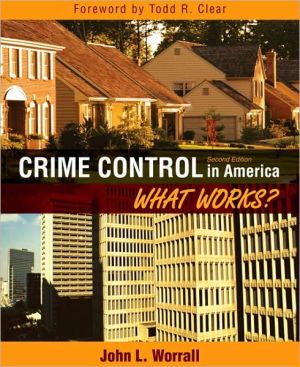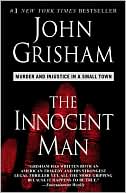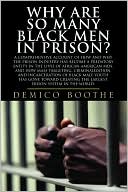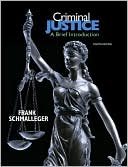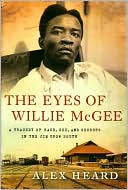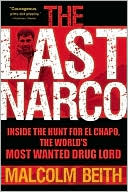Crime Control in America: What Works?
Crime Control in America: What Works? 2/e\ John L. Worrall, University of Texas at Dallas\ Crime Control in America introduces readers to the many methods of crime control and reviews the research concerning their effectiveness.\ The text covers policing, prosecution and courts, and legislative methods of crime control. It also moves beyond the justice system and examines the effectiveness of crime control at the individual, family, school, and community levels. Finally, it covers...
Search in google:
Crime Control in America introduces readers to the many methods of crime control and reviews the research concerning their effectiveness.The text covers policing, prosecution and courts, and legislative methods of crime control. It also moves beyond the justice system and examines the effectiveness of crime control at the individual, family, school, and community levels. Finally, it covers environmental criminology, juvenile crime control, and explanations of large-scale crime trends, particularly the reductions witnessed during the 1990s.
I. INTRODUCTION.1. Identifying and Evaluating Crime Control.Introduction.The Crime Problem in America.Approaches, Not Just Policies.On the Importance of Definitions.Evaluating Success: An Impossible Task?Displacement and Diffusion.The Tentative Nature of Scientific Knowledge.How Resources Dictate Public Policy and Guide Research.Academic Crusaders and Bandwagon Science.How Crime Control is Accomplished: A Preview of What’s to Come.Does it Work?Conclusion.2. Crime Control Perspectives.Introduction.Operational Perspectives.Political Perspectives.Other Perspectives.Goals of Crime Control.Conclusion.II. LAW ENFORCEMENT APPROACHES.3. Traditional Policing.Introduction.The Theory of Traditional Policing.Does Hiring More Cops Reduce Crime?Freeing Up Resources.Removing Supposed Procedural Restraints.The Problem With Being Reactive and Random.Bring in the Detectives.Other Traditional Approaches to Policing.Conclusion.4. Proactive Policing, Directed Control and other AdvancementsIntroduction.Proactive Arrests.Interrogations and Enhanced Supervision.Directed Patrol.The Broken Windows Law Enforcement Approach.Police-Corrections Partnerships.More Partnering: Multijurisdictional Drug Task Forces.Compstat.Conclusion.5. Community Involvement in Policing.Introduction.Community Justice.Problem-Oriented Policing.Community Policing: Some History.Community Policing: What is It?Community Policing: Is It Really Happening?Structural Change.The Definition Problem Rears Its Head.Research on Community Policing’s Effectiveness.Conclusion.6. Prosecutors and Crime Control.Introduction.The Harder Side of Prosecution.The Softer Side of Prosecution.A Plea Bargaining Pandemic?Conclusion.III. COURTS, CORRECTIONS, AND LEGISLATIVE APPROACHES.7. Crime Control Though Legislation.Introduction.Legislative BansGun ControlSex Offender LawsLaws Aimed at Contemporary ProblemsConclusion.8. Crime Control in the Courts and Beyond.Introduction.Courts and IncapacitationDiversionShamingRestorative JusticeAnti-Gang InjunctionsProblem-Solving CourtsConclusion.9. Sentencing.Introduction.Non-Prison SentencesTypes of Prison SentencesDoes Sentence Length Matter?Determining SentencingSentence EnhancementsMandatory SentencingSupermax PrisonsCapital PunishmentCastrationConclusion.10. Probation, Parole, and Intermediate Sanctions.Introduction.The Organization and Administration of Probation and ParoleProbation and Parole IssuesIntermediate SanctionsConclusion.11. Rehabilitation, Treatment, and Job Training.Introduction.Criminals are Not Created EqualRehabilitationTreatmentJob TrainingMore Lessons From Meta AnalysisConclusion.IV. APPROACHES BEYOND THE CRIMINAL JUSTICE SYSTEM.12. Individual, Family, and Household Crime Control.Introduction.Individual Crime Control.Household and Family Crime Control.Conclusion.13. Crime Control in the Community and in Schools.Introduction.Community Crime Control.School-Based Crime Control.Conclusion.14. Reducing Criminal Opportunities Through Environmental Manipulation.Introduction.A Quick Return to Theory.How Environmental Manipulation Occurs.The Effectiveness of Environmental Manipulations.Conclusion.V. JUVENILE CRIME CONTROL.15. Juvenile Crime Control.Introduction.Juvenile Crime.Differences Between the Adult and Juvenile Justice Systems.Recent Reforms in Juvenile Justice.Making Sense of Juvenile Crime Control.Juvenile Crime Prevention.Juvenile Crime Control.Conclusion.VI. CONCLUSION.16. Putting It All Together, Explaining Crime Trends.Introduction.A Quick Review.Three Important Themes.Explaining Crime Trends.Conclusion.
